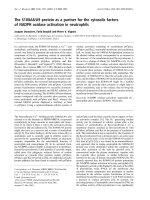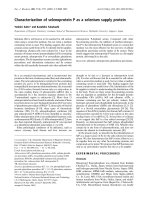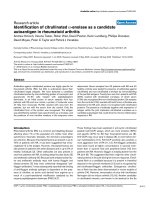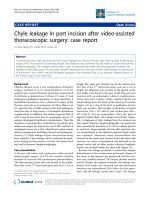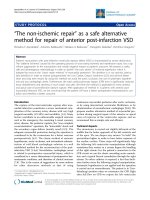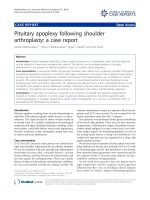Báo cáo y học: " Congenital bipartite lunate presenting as a misdiagnosed lunate fracture: a case repor" docx
Bạn đang xem bản rút gọn của tài liệu. Xem và tải ngay bản đầy đủ của tài liệu tại đây (1.19 MB, 3 trang )
CAS E REP O R T Open Access
Congenital bipartite lunate presenting as a
misdiagnosed lunate fracture: a case report
Brian WZ Loh
*
, Jason Harvey, Eugene TH Ek
Abstract
Introduction: A rare case of congenital bipartite lunate in a child is reported. Carpal variants are very uncommon
as independent entities, with only three previous reports of this condition in the English literature.
Case presentation: An 11-year-old Caucasian boy presented with pain in the left wrist after a fall. Radiographs in
the emergency department demonstrated a lunate that was divided into palmar and dorsal parts, causing a
misdiagnosis of fractured lunate. Magnetic resonance imaging was then used to differentiate between the two
diagnoses.
Conclusion: Very few cases of bipartite lunate have been reported in the literature, and unless awareness is raised
about congenital anomalies such as this variant, confusion may arise.
Introduction
The bipartite lunate is a rare congenital variation of the
carpal bones. While anomalies such as a b ipartite sca-
phoid, bipartite hamate and carpal synostosis are w ell
described in the literature [1-4], to our knowledge only
three cases involving the lunate have previously been
reported [5-7]. Here we demonstrate t he radiographic
imaging from an interesting case of congenital bipartite
lunate that was initially misdiagnosed as a fracture in
the context of trauma.
Case presentation
An 11-year-old Caucasian boy presented to the emer-
gency department after a f all onto the outstretched left
hand. Standard posteroanterior and lateral radiographs of
the wrist were performed, which demonstrated a lucent
line through the lunate. On examination, the patient
reported pain over the dorsum of the distal radius and in
the anatomical snuffbox, but no point tenderness over
the lunate. On the basis of this clinical presentation, he
was provisionally diagnosed with a fractured lunate and
an undisplaced scaphoid fracture (Figure 1). A scaphoid
plaster cast was applied, and the patient was discharged
from the emergency department. At a subsequent frac-
ture clinic review, closer inspection of radiographs
revealed that the lunate was in two distinct parts (palmar
anddorsal)andthattheundisplacedlunatefragments
were well corticated with smooth margins.
Subsequent magnetic resonance imaging (MRI) was
performed to differentiate between a traumatic lunate
fracture, a bipartite congenital variant of the lunate or an
atypical presentation of Kienböck’ sdisease.AxialMRI
images correlated with the plain radiographs showed a
linear hypointense signal between the well-defined
rounded bony margins of the palmar and dorsal parts of
the lunate (Figure 2). In the sagittal plane, the divided
lunate aligned well with the capitate and the articular
surface of the distal radius (Figure 3). The fat-suppressed
MRI images of the carpus did not show features of recent
bony injury such as bone marrow edema. Furthermore,
there wer e no features of avascular necrosis around the
lunate components. An undispla ced Salter Harris type 3
fracture of the distal radius was noted, but no scaphoid
fracture was observed. On a plain radiograph of the
opposite wrist, no partition of the lunate was noted. The
patient was treated nonoperatively with cast immobiliza-
tion. At the one-year follow-up visit, the patient reported
a complete recovery with no pain, normal power and a
return to full range of motion.
Discussion
The lunate begins to c hondrify at Streeter ’s 18th and
19th horizons of embryonic development [8]. It usually
* Correspondence:
Department of Orthopaedics, Dandenong Hospital (Southern Health),
Dandenong Victoria 3175, Australia
Loh et al . Journal of Medical Case Reports 2011, 5:102
/>JOURNAL OF MEDICAL
CASE REPORTS
© 2011 Loh et al; licensee BioMed Central Ltd. This is an Open Access article distributed under the terms of the Creative Commons
Attribution License ( which permits unrestricted use, distribution, and reproduction in
any medium, provided the original work is properly cited.
has one center of ossifi cati on that appears by the age of
two years, but double-ossification centers in the lunate
have been noted [8]. Variation in lunate ossification is
known, w ith ossification beginning between the ages of
one and a half to seven years in boys and between one
and six years of age in girls until completion between
the ages of 12 to 14 for both genders [9].
As previously mentioned, congenital bipartite lunate is
a rare occurrence and may lead to diagnostic difficulties
in the setting of acute wrist trauma and pain. However,
we did not consider the divided lunate to be a fracture,
because the MRI and plain radiograph images showed
that each part was well corticated with no evidence of
callus formation. We concluded that our case was also
unlikely to be pseudoarthrosis after a previous lunate
fracture because there was neither a history of trauma to
the wrist nor evidence of degenerative cha nge. Last, the
patient did not display any radiographic signs suggestive
of Kienböck’s disease, such as lunate fragmentatio n due
to devascularized, necrotic bone and decreased T1-
weighted signal intensity on MRI images [8].
Conclusion
Injuries to the wrist and carpal bones are extremely
common, and unless there is awareness about congenital
anomalies such as the bipartite lunate, scaphoid and
hamate, confusion and misdiagnoses may arise.
Consent
Written informed consent was obtained from the par-
ents of the patient for publication of this case report
and accompanying images. A copy of the written con-
sent is available for review by the Editor-In-Chief of this
journal.
Authors’ contributions
EE identified the patient and performed the initial investigation and
examination. BL undertook further investigation and wrote the manuscript.
Figure 1 (A) Lateral and (B) posteroanterior radiographs of the
patient’s left hand. The bipartite lunate is clearly visible on the
lateral radiograph (A; arrow). The margins of both lunate portions
are smooth and well corticated.
Figure 2 Axial T1-weig hted magnetic resonance imaging (MRI)
scan of the left wrist demonstrating the linear hypointense
signal (arrow) between the dorsal and palmar parts of the lunate.
Figure 3 T1-weighted MRI scan of the wrist in the sagittal
plane. The divided lunate (arrow) aligns well with the capitate and
the radial articular surface.
Loh et al . Journal of Medical Case Reports 2011, 5:102
/>Page 2 of 3
JH was the supervising consultant and was a major contributor in writing
the manuscript. All authors read and approved the final manuscript.
Competing interests
The authors declare that they have no competing interests.
Received: 19 January 2010 Accepted: 14 March 2011
Published: 14 March 2011
References
1. Delaney TJ, Eswar S: Carpal coalitions. J Hand Surg 1992, 17A:28-31.
2. Louis DS, Calhoun TP, Garn SM, Carroll RE, Burdi AR: Congenital bipartite
scaphoid: fact or fiction? J Bone Joint Surg 1976, 58A:1108-1112.
3. Doman AN, Marcus NW: Congenital bipartite scaphoid. J Hand Surg 1990,
15A:869-873.
4. Pierre-Jerome C, Roug IK: MRI of bilateral bipartite hamulus: a case report.
Surg Radiol Anat 1998, 20:299-302.
5. Drez D Jr, Romero JR III: Congenital bipartite carpal lunate: a case report.
Am J Sports Med 1978, 6:405-408.
6. Schmitt E, Schmitt O: Bipartite lunate bone] (Article in German). Z Orthop
Ihre Grenzgeb 1983, 121:192-195.
7. Akahane M, Ono H, Sada M, Saitoh M: Bilateral bipartite lunate: a case
report. J Hand Surg 2002, 27A:355-359.
8. Doyle JR, Botte MJ, ed: Surgical Anatomy of the Hand and Upper
Extremity. Philadelphia: Lippincott Williams & Wilkins; 2003, 52-55.
9. Stuart HC, Pyle SI, Cornoni J, Reed RB: Onsets, completions and spans of
ossification in the 29 bone-growth centers of the hand and wrist.
Pediatrics 1962, 29:237-249.
doi:10.1186/1752-1947-5-102
Cite this article as: Loh et al.: Congenital bipartite lunate presenting as
a misdiagnosed lunate fracture: a case report. Journal of Medical Case
Reports 2011 5:102.
Submit your next manuscript to BioMed Central
and take full advantage of:
• Convenient online submission
• Thorough peer review
• No space constraints or color figure charges
• Immediate publication on acceptance
• Inclusion in PubMed, CAS, Scopus and Google Scholar
• Research which is freely available for redistribution
Submit your manuscript at
www.biomedcentral.com/submit
Loh et al . Journal of Medical Case Reports 2011, 5:102
/>Page 3 of 3
